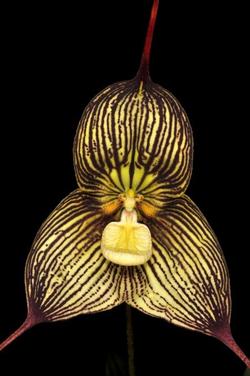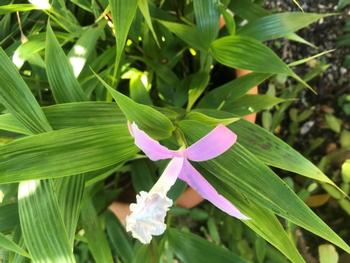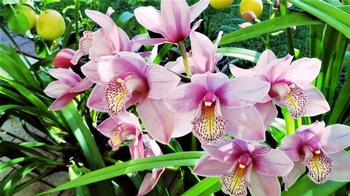Growing orchids outdoors in Marin
-
We’re fortunate to find beautiful and long-lasting orchids in almost every grocery, nursery, and gift shop these days. Most of these floral beauties are relatively common Phalaenopsis, commonly known as butterfly orchids. They are graceful and available in a variety of colors.
Question is, are you looking for more? How about a Dracula? A Sobralia? Or the more familiar Cymbidium?
The orchid family is one of the largest in the plant world. Shortly after World War II, the orchid industry exploded. Unlike most consumer goods, orchids have actually dropped in price!
Choosing and growing orchids
When selecting an orchid, look at the flowering stem first. Don't buy an orchid whose buds are all open; you want the flowers to open slowly when you get the plant home.
Orchids need a lot of light. If you plan to keep them indoors, put them near a window where they will receive a lot of natural light but not so much that they might burn. In the wild, orchids grow on trees with their roots exposed. They grow from trunks and branches. And they survive untended on light, air, and rainwater.
Draculas: invite a dragon into the garden
Draculas are epiphytic and thrive clinging to mossy branches of trees in cloud forests. The majority of their blooms extend downward or horizontally from the plant. They can be planted in well-ventilated plastic pots or baskets that allow the flower spikes to hang below the plant or mounted on bark. Sphagnum moss or a combination of tree fern bark and chopped sphagnum or perlite is an ideal potting medium to help retain moisture and simulate their native environment. Draculas have no pseudobulbs and minimal water-storage tissue. Dracula ‘Bela Lugosi’ is a hybrid of the vampire orchid found growing in the cloud forests of Equador. Photo credit: Ron Parsons
Dracula ‘Bela Lugosi’ is a hybrid of the vampire orchid found growing in the cloud forests of Equador. Photo credit: Ron ParsonsFog and moderate temperatures, found in many parts of Marin, are ideal for growing Draculas, which are native to Central America, Colombia, Ecuador, Mexico, and Peru. Ideal cultural conditions exist at higher elevations of these regions. They rely on high humidity and cannot tolerate a freeze or extended periods of hot, dry weather.
More than 100 species have been identified since they were discovered in the 1880s. They were classified in the genus Masdevallia until 1978 when they received their own genus classification. Challenges for Dracula orchid survival in their native environment include loss of habitat, overly ambitious collectors, and climate change.
The name “Dracula” literally means “little dragon” for the flower’s resemblance to mythical beasts and is not a reference to the infamous Count Dracula. The “faces” of these tiny orchids resemble monkeys, bats, or lambs, and photos often seem to be digitally enhanced. Look for these darlings in person at orchid shows and specialty nurseries -- then add them to your collection if your locale offers the proper climate.
Sobralias: made for Marin’s Mediterranean climate
Sobralias are the perfect Cymbidium companion! Ideally suited for our Mediterranean climate, Sobralias love the warm summer days and cool summer nights that they need to bloom. Many California growers treat their Sobralias as garden plants and are rewarded with copious, colorful flowers each year with relatively little care. Growers in other areas can succeed with Sobralias if they can duplicate this climatic regime. If plants can be grown outdoors during frost-free months, they will have enough light to set spikes. This lovely Sobralia blooms in a Mill Valley garden. Photo credit: Jane Scurich
This lovely Sobralia blooms in a Mill Valley garden. Photo credit: Jane ScurichUnfortunately, despite their beautiful ornamental bamboo look, their high light requirements keep them from making good houseplants.
Flowering is done in succession, one flower at a time. A bloom unfolds, holds for a few days,
then fades as another bud develops and flowers. This process repeats, so each spike may give you up to three blooms from the same flowering tip.Sobralias are happy when summer nights are in the 50s and summer days are in the 70s and low 80s. In cooler months they do fine into the 30s before needing frost protection. When temperatures approach freezing, plants may be damaged, so some overhead protection is needed.
Sobralias need all the light you can give them, short of burning the leaves. Along the California coast, plants will tolerate nearly full sun, with dappled shade to protect them from the hottest noon-day sun. The further inland one goes, the more mid-day shade is needed. Leaves should be light green and naturally upright. Limp, dark green foliage is a sign that plants are not getting enough light. Insufficient light is the most common reason Sobralias fail to flower.
Sobralias are fairly tolerant of lower humidity but will do best with 50 to 60 percent. Humidity should rise with the temperature. If it gets super hot, damp down around the plant to take some stress away.
Water plants every five to seven days. Fertilize with a balanced fertilizer year round. Plants should be repotted into fresh mix every two to three years, depending on the health of the mix. If it is broken down and soft, repot. Potting is best done right after flowering to allow maximum time to re-establish before spiking the next season. Do not be too anxious to divide, as best flowering is on large plants. Never divide down to fewer than eight canes. If you see significant leaf drop after repotting, don't worry. The new growth will soon leaf out. Use Cymbidium-style potting media for best drainage.
Cymbidiums: A Bay Area favorite
Cymbidiums are beloved Bay Area beauties. They usually bloom in early spring, although some may bloom as early as October. Cymbidiums fill the early spring garden with color. Photo credit: Pexels
Cymbidiums fill the early spring garden with color. Photo credit: PexelsCymbidiums are native to the foothills of the Himalayas and mountainous areas of Burma, Thailand, and Vietnam. In our sub-tropical area, Cymbidiums are standard outdoor plants year round. They are not suited for growing indoors year round because they require high light in the daytime and cool temperatures at night, but they may be brought indoors when in bloom.
Light is the most important factor in attaining good Cymbidium culture. Mature Cymbidiums need bright filtered light all day or full morning sun.
While Cymbidiums may be considered temperature tolerant, most require periods of cooling in order to bloom. Flower spikes are initiated in autumn when the differential between day and night temperatures plays a key role. The ideal temperature range for cymbidiums is 40 to 90°F. During cold spells, Cymbidiums can take 32°F but should be given some protection in case the temperature drops further. To guard against effects of the cold, plants should be moved up against the house or under a tree.
Water Cymbidiums thoroughly, then allow the mix to almost dry out before watering again. Fertilizer should be provided throughout the year, as the potting medium provides very little nutrition.
When the potting medium has broken down or the plant is growing over the sides of the pot, it is time to repot your Cymbidium -- probably every three to four years. First, take the plant out of the pot and remove the old bark. Cut away any dead or compacted roots from the bottom of the root ball. Always sterilize cutting tools between plants.
If you decide to divide the plant, look for natural divisions that allow three to five-bulb groupings. Select a pot size that will allow the plant to grow unrestrained for three to four years. Usually, two inches between the plant and the side of the pot is sufficient. When placing the plant in the pot, position the bulbs so they sit just a little into the surface of the medium and so that the newest growth is in the center of the pot, with room to grow. Plants should be potted firmly by pouring the medium around the roots while tapping the sides of the pot and pushing down on the top with thumbs or a potting stick. Potting medium should be fir bark, coconut chips, or commercial orchid mix. Do not use soil or potting mixes that hold too much water.
Seek out some of these truly rewarding orchids from local specialty nurseries and add an exotic touch to your garden.
Sources:
https://hgic.clemson.edu/factsheet/orchids/
https://ucanr.edu/blogs/blogcore/postdetail.cfm?postnum=16322
mbmg.ucanr.edu/files/262345.pdf
mbmg.ucanr.edu/files/262343.pdf
https://www.montereybayfarmers.org/market-news/caring-for-cymbidium-and-orchid-plants
By Jane Scurich



